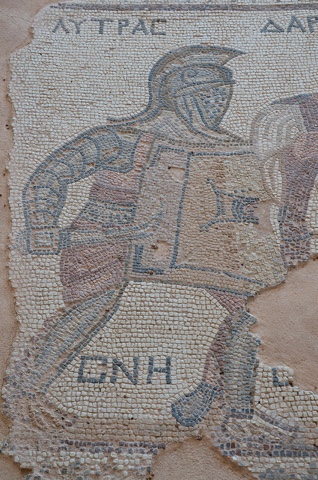Museum Exhibitions and Changing Perspectives
On Friday the Gladiators, Heroes of the Colosseum exhibition opened at the Queensland Museum, and it has already had an impact upon me despite the fact I haven't yet seen it. My brother is working as a volunteer, and he came home from his first day posing a question he was asked but was unable to answer: "Did gladiators wear padding inside their helmets?"
The Museum has gotten some helmet reproductions for people (they were thinking about children but adults aren't letting the kids have all the fun) to try on and have their photos taken. Apparently they are very heavy and a little uncomfortable, so the question is literally top of mind.
I didn't know the answer, so I immediately started looking into it. Reenactors were arguing that they did, and some based their theory on what they see as an undergarment on friezes and mosaics. The picture below is of one they suggest supports the theory. I'm not completely won over, but I do concede that padding would be safer and more comfortable, but where's the irrefutable evidence?
So I started looking for discussions on helmets, and was shocked to see Juvenal's Sixth Satire (a work I've read multiple time before) appear:
Yes, I'm looking forward to going and seeing the exhibition, and you bet I'm going to have my photo taken in one of those helmets, but I am looking forward to the questions posed by the public that my brother will bring home to me far, far more. Those questions will be posed by people with few (if any) preconceptions about what is known or understood, with the exception of movies, and as a result their questions draw the mind to reconsider what we assume, and that is why exhibitions like this make our research better and stronger.
The Museum has gotten some helmet reproductions for people (they were thinking about children but adults aren't letting the kids have all the fun) to try on and have their photos taken. Apparently they are very heavy and a little uncomfortable, so the question is literally top of mind.
I didn't know the answer, so I immediately started looking into it. Reenactors were arguing that they did, and some based their theory on what they see as an undergarment on friezes and mosaics. The picture below is of one they suggest supports the theory. I'm not completely won over, but I do concede that padding would be safer and more comfortable, but where's the irrefutable evidence?
 |
| Detail of a mosaic depicting gladiators being separated by a referee, late-3rd century AD, House of the Gladiators, Kourion, Cyprus https://www.flickr.com/photos/carolemage/ |
But what were the good looks and youthfulness that enthralled Eppia and set her on fire? What did she see in him to make her put up with being called a gladiator's groupie? After all, her darling Sergius had already started shaving his throats and with his gashed arm had hopes of retirement. Besides, his face was really disfigured: there was a furrow chafed by his helmet, an enormous lump right on his nose, and the nasty condition of a constantly weeping eye. But he was a gladiator. That's what makes them into Hyacinthuses.
Lines 103-110 Braund translation (Loeb Classical Library)Never had I paid any attention to the description of what the helmet had done the the fictional Sergius' head. I'd noted his injuries, his medical condition, the idea that he might soon retire, and that it was only through his role as gladiator that he had any physical appeal, but that chafed furrow from his helmet had never caught my imagination, until my brother passed on that question he was asked.
Yes, I'm looking forward to going and seeing the exhibition, and you bet I'm going to have my photo taken in one of those helmets, but I am looking forward to the questions posed by the public that my brother will bring home to me far, far more. Those questions will be posed by people with few (if any) preconceptions about what is known or understood, with the exception of movies, and as a result their questions draw the mind to reconsider what we assume, and that is why exhibitions like this make our research better and stronger.
Exhibitions make for stronger research outcomes.


Dear Yvette,
ReplyDeleteThere is a fragment of Sappho, which, in one of those postmodern twists, has content mirroring its fragmentary form, about shepherds in the mountains and crushed hyacinths.
Like the wild hyacinth flower which on the hills is found,
Which the passing feet of the shepherds for ever tear and wound,
Until the purple blossom is trodden into the ground.
And, in another small piece of coincidence - proof that "God" does not exist because she would not expose herself in this manner - I was once talking to a student in the Albert Street Mall who was reading a book on methodology. I was asking the student about how one would approach a methodology of fragments, mentioning, in doing so, the small fragment about hyacinths in Sappho's writings. She later told me that here name was Jesinta. (Of course that prompted the old joke about division tables ("three jesinta/"goes inta" twelve four times", etc.
You may also care to examine Jean Broc's "The Death of Hyacinthus", from 1801, showing Apollo supporting a swooning beloved. Broc was a student of Jacques-Louis David, and one of the leaders of the rebellious students called the Barbus.
Also, in Lucian's Amores/Erotes the hyacinth is used with suggestion of the fluidity of sexuality. T. S. Eliot's "The Waste Land" features a girl carrying hyacinths, and much has been made about whether she is a literary stand-in for Eliot's friend (lover?) Jean Verdenal.
Of all the things I thought people might comment regarding this blog, I didn't expect hyacinths. Thanks Greg.
ReplyDelete